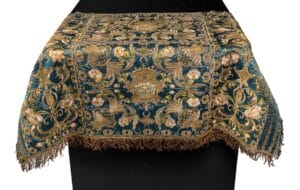(JNS)
Few art aficionados can rattle off many names of 18th-century women artists. And one who is Jewish? That’s almost like chancing upon a yeti riding a unicorn.
Having bought a Torah ark curtain by Simhah Viterbo (1739-79) in 2019, the Saint Louis Art Museum is sticking with the Jewish artist, whose husband and son were rabbis.
In December, it bought an embroidered cover for a synagogue reader’s desk—more commonly known as a bimah—at a Sotheby’s auction. The textile bears the Viterbo family emblem of grape clusters; vite is “grapevine” in Italian, so curators at the museum believe Viterbo made that piece as well.
Little is known of the artist, who lived in Ancona, a port city in central Italy where, per the museum, she likely resided in a Jewish ghetto.
“Despite this segregation, the rich materials and complex design of Viterbo’s textiles attest to her connection to both trading networks and artistic trends across Italy and the Mediterranean world,” according to the museum. “Writings left by her son refer to her as an artist, and two other works known to be by Viterbo are in private collections in Israel.”

Cover for a reader’s desk or bimah (mid-18th century Italian), likely the work of Simhah Viterbo. Photo courtesy of the Saint Louis Art Museum.
Genevieve Cortinovis, the St. Louis museum’s assistant decorative arts and design curator, called the new acquisition “a superb example of 18th-century Italian embroidery.” Though known for Renaissance painting, Italy produced textiles that were renowned in Europe for their quality, she added.
The museum showed Viterbo’s ark curtain in the exhibit “Signed in Silk: Introducing a Sacred Jewish Textile” in 2021. It noted that Viterbo was a teenager when she made the curtain and “embroidered her name across the lower edge of the textile in Hebrew: ‘made by the young woman Simhah Viterbo in the year ha-yashar ve-ha-tov,’ ” which corresponds to 5515 in the Jewish calendar, or 1755.
“In addition to the beauty and evident attention to detail in this rare and exceptional textile, we hope it will also aid in reconstructing the biography of Simhah Viterbo, an important 18th-century woman artist about whom not enough is known,” said Min Jung Kim, the museum’s director.
Cortinovis, the curator, told JNS that a book inscription describes Viterbo’s father as a rabbi as well, so she may have had three rabbis rather than two in her family. “But much less is known about him,” Cortinovis said of the artist’s father.
Since the museum acquired the first work by the artist, Cortinovis and colleagues found a relevant, 11-page document about the artist and her husband, Mordechai Raphael Viterbo, at the Jewish Theological Seminary Library in New York City. “We are in the process of getting it translated and believe it will shed more light on her father, and perhaps also her mother, who we have been unable to identify,” said Cortinovis.
The museum’s collection also includes a pair of gilded silver Torah finials, dated 1778, by the German-born Dutch artist Wilhelmus Angenendt.








